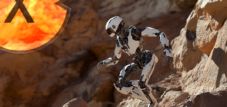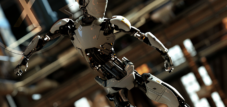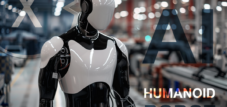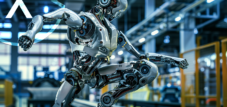Published on: March 31, 2025 / update from: March 31, 2025 - Author: Konrad Wolfenstein

The humanoid robot Ameca, the man and machine connects - from trade fairs to museums he conquered the world - image: Engineered Arts Limited
Ameca: How this humanoid robot shapes the future of interaction
From trade fairs to museums: Ameca conquers the world - what is behind it?
Ameca, one of the most advanced humanoid robots in the world, fascinates with its human -like interaction skills and its highly developed design. With the rapid development of humanoid robot technology, Ameca represents an important milestone that increasingly makes the boundaries between humans and machines blur.
Development and history of origin
Ameca was developed by the British company Engineered Arts and represents their top performance in the humanoid robotics. The project started in February 2021, with the first video recordings of the prototype being released on December 1, 2021. Even before his first public demonstration at the Consumer Electronics Show (CES) in January 2022 in Las Vegas, Ameca received great attention through viral videos on Twitter and Tiktok.
In 2022, Ameca presented an “alternative Christmas message” that was broadcast by the British public television station Channel 4. This underlined the growing cultural importance of the robot. The development of Ameca continuously progresses; In 2024, a copy was brought to Edinburgh, UK, to reside in the National Robotarium.
Suitable for:
- Humanoids, industrial and service robots on the upswing- humanoid robots are no longer a science fiction
Angelina Jolie similar?
There is no official statement or intention on the part of the developers of Ameca to make the humanoid robot Angelina Jolie similar. However, some people in online discussions noticed that Ameca has a certain similarity to Angelina Jolie, especially with regard to the facial features and facial expressions. This perception is subjective and could be influenced by the human -like facial expressions and the detailed mechanics of the robot.
Ameca was developed by Engineered Arts with a gender -neutral and universal design to promote broad acceptance and not to refer to specific human faces or celebrities. The similarity to Angelina Jolie therefore seems to be more random and dependent on the interpretation.
Technical specifications and design
Ameca was developed with the aim of enabling human -like interactions and preserving a gender -neutral appearance. With a height of 187 cm and a weight of 49 kg, the robot corresponds to the average human size.
The outer design is characterized by gray rubber skin on the face and hands, which gives the robot an unmistakable but yet familiar appearance. The conscious decision for a gender -neutral design without hair underlines the focus on functionality and universality.
Advanced mechanics and sensors
The movement ability of Ameca is made possible by an impressive number of electrical engines. In previous versions, the robot had 52 electric motors that control the head, face, arms and hands, whereby 17 engines alone were responsible for the facial movements. In recent versions, the number was increased to 61 engines, with up to 27 engines solely for refined facial expressions.
Ameca is equipped with various sensors for the perception of the environment:
- Binocular cameras in the eyes for spatial seeing
- A breast camera for the surrounding area
- Binaural microphones for directional listening to the ears
- Integrated speakers on the chest for the voice output
This sensor configuration enables precise motion tracking, facial recognition and speech recognition, which enables natural interactions with people.
Suitable for:
- Robot Development: Sophia, developed by Hanson Robotics, is one of the most advanced humanoid robots in the world
Artificial intelligence and interaction skills
AI integration and language skills
Ameca is primarily designed as a platform for the further development of technologies for human-robot interaction. The particular strength of the system lies in the integration of advanced AI models. GPT-3 from Openai was used in previous versions, while newer models work with GPT-4O.
This AI integration enables Ameca to talk smoothly about various topics and to answer questions coherent and well thought out. A special system was developed in the Future Museum of Nuremberg that can simulate various “moods” and character traits - from helpful assistance to ironic or humorous interactions.
Emotion expression and non -verbal communication
An outstanding feature of Ameca is the ability to communicate non -verbal. The robot can represent a wide range of emotions such as luck, surprise and anger through facial expressions. This emotional expression is made possible by the numerous engines in the face area and makes interactions more natural and intuitive.
In addition to the facial expressions, Ameca can accompany his voice output with suitable mouth movements and gesture with arms and hands. This combination of verbal and non -verbal communication contributes significantly to human -like interaction ability.
Current areas of application and installations
Ameca has found global distribution in various educational and cultural institutions since its introduction:
- Since July 2024, a copy has been permanently exhibited in the Future Museum in Nuremberg, where visitors can interact directly with the robot
- In the Computer History Museum in California, Ameca is the focus of an exhibition called “Chatbots Decoded: Exploring Ai”
- Further installations can be found in the Copernicus Science Center in Warsaw, in the Museum of the Future in Dubai and in the German Museum Nuremberg
- Ameca was presented as a crowd puller
In addition to museum applications, Ameca is also used commercially:
- At events of the pharmaceutical giant GSK for interaction with trade fair visitors
- In Madison Square Garden's Sphere in Las Vegas for entertainment purposes
- At the OMR Festival 2022, presented by Vodafone
These diverse areas of application underline the wide range of applications of the humanoid robot.
Research projects and scientific applications
At research institutions, Ameca serves as a platform for the further development of human-robot interaction. Since 2022, a team on the RPTU has developed a real-time people-robot-robot interaction system (EMAH) based on an AMECA robot of Generation 1.
The EMAH system uses rule-based behavior models, custom machine learning and deep learning architectures for realistic communication between humans and robots. These research projects contribute significantly to the further development of humanoid robotics and open up new applications in areas such as health care, education and service robotics.
Corporate development and future prospects
Company structure and financing
Engineered Arts, the company behind Ameca, has undergone significant developments in recent years. In 2024, the originally British company as a US company has restricted itself to expand its presence and to meet the growing demand in the USA.
This restructuring was accompanied by a successful series-A financing round, in which $ 10 million was collected, which increased total financing to $ 16.2 million. It is noteworthy that Matt Bellamy, the front man of the British rock band The Muse and Partner at Helium-3 Ventures, joined the board of the robotics company as an observer.
Product development and market expansion
Engineered Arts plans to make both full-format and desktop versions of Ameca Breiter available. An example of the smaller versions is the desktop android “Azi”, which is equipped with 27 actuators for facial expressions and five for neck movements.
Further development plans include:
- Improvement of the mobility and mobility of the robots for everyday use
- Development of a virtual robot character platform
- Expansion of cloud-based AI services
- Opening of regional offices and hiring of 20 new employees for the location in Redwood City, California
These plans for the future illustrate the efforts to remove humanoid robots like Ameca from the pure exhibition context and to bring them closer to commercial everyday applications.
From the exhibition on everyday life: Amecas Way into our lives
Ameca represents the current climax in the development of humanoid robots that can of course interact with people. Through the combination of advanced mechanical construction, comprehensive sensors and powerful AI integration, this robot sets new standards for human-machine interaction.
The increasing presence of Ameca in museums, research institutions and commercial applications illustrates the growing interest and the acceptance of humanoid robots. With the ambitious future plans of Engineered Arts, Ameca could soon become a practical assistant in various areas of life from a pure exhibition object.
However, the development of Ameca also raises important questions about truth, data protection, discrimination and the core of human existence, which must be taken into account in the further social examination of humanoid robotics. The Future Museum Nuremberg already sees it as its task to take these questions in the context of interaction with Ameca.
Suitable for:
Your global marketing and business development partner
☑️ Our business language is English or German
☑️ NEW: Correspondence in your national language!
I would be happy to serve you and my team as a personal advisor.
You can contact me by filling out the contact form or simply call me on +49 89 89 674 804 (Munich) . My email address is: wolfenstein ∂ xpert.digital
I'm looking forward to our joint project.













